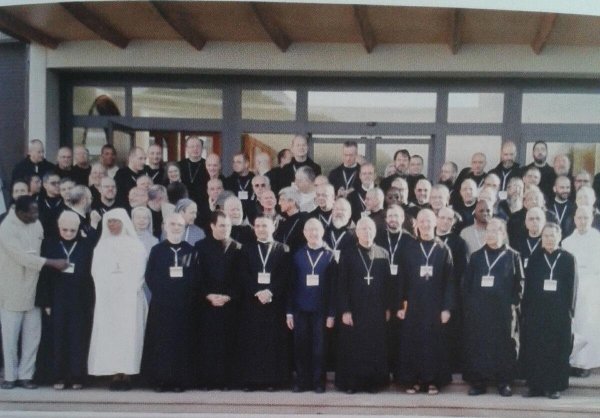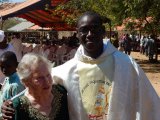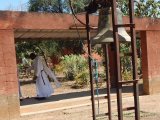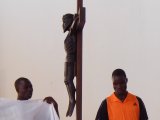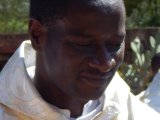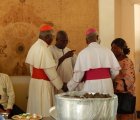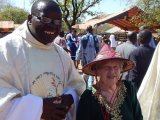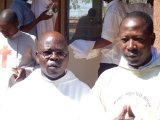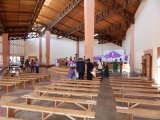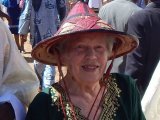Page 5
Oblate Birthday
19 Dec 2016
Birthday party for Oblate Monica Cowell of Chichester. The cake was made and given by the Sisters of Nazareth in Chiraa.
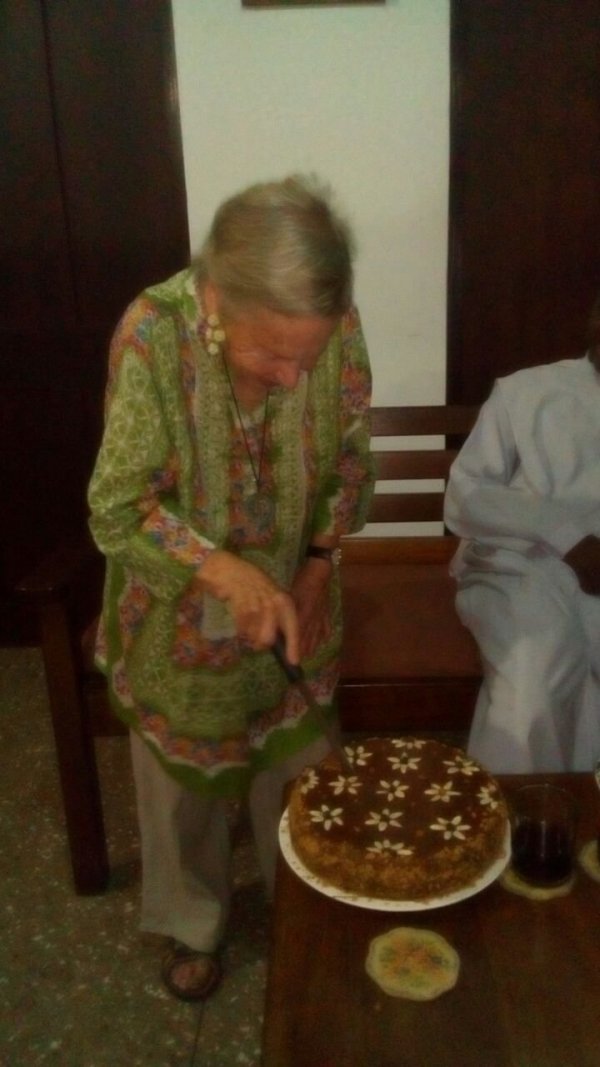

Brother Cyprian News
25 Nov 2016
Notes from Fr Mark of Pluscarden
I am looking after Brother Cyprian of Kristo Buase, a monk in temporary vows, who is here at Pluscarden for a while. As I did not receive much warning, I had no time to prepare and I now find that there are all sorts of minor practical matters that have to be taken care of. Often a few moments thought would have brought them to mind, but I have not thought of them and they suddenly appear and have to be dealt with. My famous memory does not help. It is not the forgetting that is wearing: when I forget, I forget. However I keep on remembering again before forgetting again. I forget and remember again dozens of times in the day, often when I can do nothing about it.
Last week was dominated by the story of the medicines. In West Africa hypertension is common and Br Cyprian suffers from it. He left all his medicines behind and did not know what they were. We had to get him registered temporarily at the medical centre and then we had to get him to see a doctor. In the meantime we got in touch with Ghana to find out what had been prescribed but they did not know! On Monday Br Cyprian saw a doctor who gave him the wrong prescription to begin with. Then a copy of his Ghanaian prescription arrived from Kristo Buase, sent by Whatsapp. Then the surgery phoned to say the prescription their doctor had issued was wrong. We had to go in on Wednesday to get the right prescription and a new set of application forms for full registration with the medical centre; Br Cyprian had left the first set with the doctor he saw, but completely blank. By Friday he had one of the drugs he needed and appointments for a clinic to be tested for his high blood pressure so he could get the other two. That day he also put in his application to be fully registered with the surgery. With a bit of luck things will get straightened out.
In the meantime I am trying to get one or two things started. Although I intend to put up a notice in the novitiate laying out the planned meetings for the week, I have, in fact, been going from day to day while I work things out. There are always things to be taken into consideration like the veg squad and dies nons and solemnities. Today, being Christ the King is a solemnity.
I have also been getting in touch with people for other things. I have made the first steps in getting music lessons and in getting him into a class for ESOL (English for Speakers of Other Languages). For the ESOL there are forms to be filled in and assessments to be undergone. The classes don't start until January if he is Intermediate 4, but not until August if he is Intermediate 5 or higher – if I have understood it right.
There were dies nons that week. By tradition the seniors take their dies non on Thursday and the juniors and those working with them on Friday. This meant I took my day off on Friday, though I spent the day taking Br Cyprian out in a car. We began with a misunderstanding which meant me standing in the cloister waiting for him and him standing outside in the cold half way down the drive waiting for me. We didn't go far or do very much. The first thing we had to do was to hand in the forms to apply for registration at the surgery. It was empty with no crowds of patients waiting for a doctor and only clerical staff visible. We passed over the forms and left.
As Br Cyprian had never seen the sea, we went to Lossiemouth, the nearest place where we could see it. It was a cold day with a white frost that remained all day in those places hidden from the sun. I had to assure Br Cyprian that he needed a jumper over his colourful, Ghanaian, going out on a day off type shirt. Yet, sitting on their boards in the sea off the beach at Lossiemouth, there were three or four surfers in neoprene suits waiting for waves to curl into the shore. I had the video camera with me and could only hold it for a few minutes, so cold was it, yet they were out there in the sea waiting for the perfect wave. When they did ride an occasional wave, they seemed to fall off as often as they rode the breaker to the shore. As this was Lossiemouth the waves were not as big as at Santa Monica, Hawai or even Cape Coast.
We ate lunch in a restaurant. Afterwards we walked up to the harbour. Nothing was moving. Most of the boats we saw were yachts in the marina bit, though there seemed to be a couple of small fishing boats and another working boat which looked as though it was some sort of private marine research vessel. The fishing boats seemed to be using hooks and lines going out from bobbin like things set in patterns around the deck and wheelhouse.
After this we left Lossiemouth and moved along the coast to Burghead. Again it was quiet, but we could see over the Moray Firth from the headland and down into the harbour from the side of the fort. While we were there, a fishing boat set out from the harbour to Br Cyprian's delight, for he had never seen a boat putting out to sea in his life.
We went from there to Sueno's Stone in Forres. Driving west from Lossiemouth to Burghead and then from Burghead to Forres on a November afternoon was dazzling. Despite sunglasses and the sun-visor down, there were moments when I was effectively blinded by the sun almost horizontally in front of me. It was time to go home, so we went home.
Fr Mark
November Update
25 Nov 2016
An American friend of ours, Herbert Schultz, provided funds for us to obtain for our monastic library seven works of St John Chrysostom, and two works of St Cyril of Alexandria.
In our area, this is the season of the Yam festivals. Our guest from Prinknash Abbey, Mary Jones, attended the Tuobodom Yam festival on 24th October. These two low resolution photos she took on her phone. 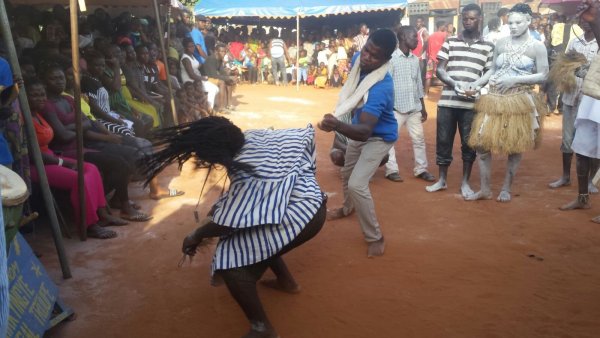
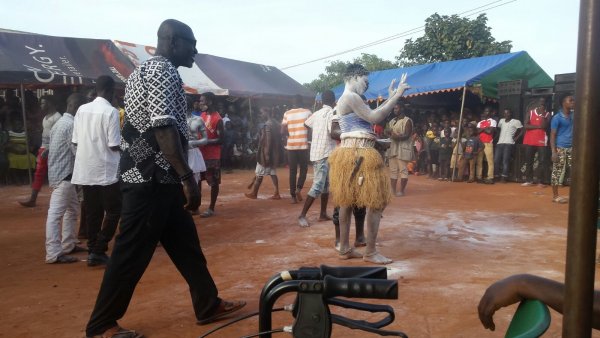
There have been a few changes in officials at the monastery:
- Brother Basilio is now Novice Master,
- Brother Antony is Oblate Master.
Please pray for these brothers who showed a great spirit of obedience in accepting these tasks.
A number of priests have been here on retreat in the past two weeks. First there were two Divine Word Missionaries, working in Accra, then Father Daniel of the Goaso diocese, and finally Father Gabriel of the Archdiocese of Accra.
At present, we have a monastic guest from the Abbey of Koubri in Burkina Faso - Brother Anthelm. He is a very cheerful presence in the community, ever willing to help. He has no English and our oblate, Monica Cowell, is giving him classes in English twice daily.
2nd November, All Souls, is a day in where traditionally the whole monastic community gathers in the cemetery for prayers for deceased community members. At Kristo Buase, we gather in the cemetery for Midday Prayers, sometimes called Sext. We also bless the graves. Our cemetery is in a quiet grove and at its entrance there is a beautiful cross.
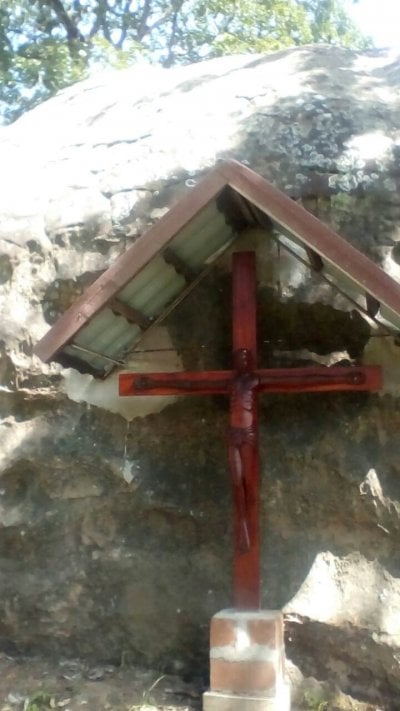
We continue to pray for you all, and ask that you do the same for us, especially in the lead up to the Presidential Election here in Ghana in December.
THE ELEVATION OF KRISTO BUASE MONASTERY TO THE STATUS OF A PRIORY SUI JURIS AND THE ELECTION OF A PRIOR
10 Sep 2016
THE GOOD NEWS
On the eve of the 27th anniversary of the Kristo Buase monastery the news came that the Abbot President was about to sign the document which was going to confirm and declare the long awaited autonomy of the community, from the three founding houses in England and Scotland, becoming a Priory sui juris on 6th August, 2016.
On the 15th August, the community went through the process of electing their first prior (this was conducted under the supervision of the Abbot Francis of Prinknash abbey). The chapter fathers had elected the first prior of the priory and he was in the person of Dom Bede Kierney of Pluscaden Abbey. There has to be a ceremony to install him. This was the responsibility of the Abbot Francis but due to travelling arrangements, he delegated his powers to the the Bishop of the diocese of Techiman, the resident diocese of the monastery. This ceremony was to be followed by a thanksgiving mass, which the whole community in accord with the prior elect had decided to celebrate in a grand style and this required the organization of the event in less than two weeks.
All was set for the ceremony of the installation on 9th September; the Bishop Dominic of Techiman had been very prompt as usual hitherto he had promised 4:00pm therefore arriving in his full regalia at ten to four. The ritual began by the reading of the declaration to the hearing of the conventual house and was followed shortly with the oath of the prior elect. Afterwards the Bishop led Dom Bede to the chapel stool at the head of the other chapel stools purposely for the new prior of the new priory and installed him on the stool. The new prior then gave his speech; calling to mind that he was actually elected to serve and not to be served.
The ceremony was ended with photographs in the cloister, while the Bishop thanked Dom Ambrose Flavell who had been very instrumental on the quest of the attainment of autonomy for the house.
THANKSGIVING MASS, 10th SEPTEMBER
This event was witnessed by people of all walks of life, from the dioceses of Techiman, Sunyani, Donkorkrom, Kumasi, Ouagadougou and beyond.
The event was graced by the presence of the Bishop Dominic Yeboah Nyarko of the Techiman diocese who was the main celebrant and the Bishops, Matthew Kwasi Gyamfi and Gabriel Kumordzie, from the diocese and Apostolic Vicariate of Sunyani and Donkorkrom respectively and the V. Rev. Fr. Dominic Apee, president of the Ghana major superiors Association were all in attendance to con-celebrate. Also in attendance were the priests, monks and religious from Techiman, Sunyani , Kubiri and beyond, medical personnel, Government officials, the Armed and Police forces, Chiefs and Queen mothers, etc.
After the start of the mass with the long procession, the V. Rev. Fr. John Kofi Takyi (vicar-general of the Techiman diocese) gave the welcome address, beginning with a monastic quote “the challenge the society poses to the monastic life is not due to it’s alienation from social fixtures but it’s concern for the salvation of the society”, he continued to state that “the spiritual and material growth of a society is always due to the existence of the church represented by a monastery or a priory”. He appreciated therefore the effort of all who had helped the monastery to this far, urging more people to seek solitude within the confines of the of the monastery, for the renewal of the their spiritual lives.
HOMILY
Bishop Matthew Kwasi Gymfi during his homily appreciated the weather (over cast), thanking God for how far he had brought the community, describing how the environment was at the time the monastery was inaugurated and noted that “the monastery was of an impregnable spiritual repute”. He actually went into a detailed explanation of an autonomous monastery and what the new status was to expect in the near future, exhibiting the depths of knowledge he had as regards to the monastic setting. The Bishop congratulated the monastery and commended all those both dead and alive whose effort and instrumentality had contributed to the immensely to this new achievement and in silence remaindered us of Dom Martin Simons, Dom Leo, Dom Bartholomew Banzie and Bishop Kwadwo Owusu, the formers who were superiors and members of the community and the latter the late Bishop of Sunyani. He then went on to acknowledge the Nana Amisare Dwomor 2 chief of Tanoboase for his generosity and that of his predecessor, for the vast land of which the monastery is proud of. He could not finish without the acknowledgment of the gigantic support of the three founding houses; Prinknash, Pluscarden and Ramsgate now Chilworth all in U.K., for their hard work and toil to nurture for this young child of theirs to its independence.
The main focus of his homily was on: independent, inter-dependent and dependent. He explained each of these and the interconnectivity they all had with each other, therefore relating it to the new autonomous priory of Kristo Buase. He stated that the independence of the community was not to be taking as the independence of the individuals in the community but the brethren were now to live most especially in inter-dependency thus each one depending on the other in the community and not each going on their diverse ways, the brethren were he said were to remain in unity in order to be strong and be bound to the love of God, as Christ himself tells us “remain in My love”. “Each member of the community”, he said, “was not to listen to the rhythm of his own drum alone but to the rhythm of the others, for he who listens to the rhythm of his own does not avail himself to new ideas, the diversities and the acknowledgment of others, which will go a long way to avoid mediocrity, vain glory and the wallowing in our ignorance due to self centeredness”. His Lordship in his conclusion made reference to the edifices of the monastic communities he had visited so far, especially those of the three founding houses of Kristo Buase and how these buildings themselves emitted and demonstrated dialogue in a special way. He made mention of the monks’ unlike the other religious congregations, resistance of the trends of the times as unhealthy and their preference for the opposing side. He ended with congratulatory messages to the first Prior of the new Priory, V. Rev. Dom Bede Kierney OSB. and the whole community and with one voice with Apostle Paul’s letter to the Ephesians1:1-3: Blessed be the God and father of our Lord Jesus Christ who has bestowed in us every spiritual blessing in Christ.
THE PEAK
The Bishops during offertory informed Prior Bede that he needed to be installed in the presence of all gathered and most especially in the presence of the Chiefs and the elders so that they could come forward to greet him, since this was something very peculiar in the Ghanaian setting that a chief does not stand to greet someone unless the person is elevated before him. Before the second collection the three Bishops installed Prior Bede of a Chiefs stool, sitting him down three time in the name of the Holy Trinity, then all came to greet him including the chiefs with his Queen mother and elders while the wonderful Dagaaba choir sang.
CONCLUSION
Rev. Dom Ambrose Flavell gave the vote of thanks, after the mass came to a close and yes he gave an extraordinary exhortation and a wonderful advice to the Prior, since he had experienced Kristo Buase as the Superior for many years.
The party afterward, as now we call the reception of every great ceremony, was on point since there were provisions made for the refreshment and nourishment of all who attended the event. All left in great satisfaction, for they had been blessed by this wonderful celebration and the grace of God was now abiding in them. In the evening after the community said good bye to the oblates who came from Accra, as they were the last to leave, sat at recreation to savour the lasting sweetness of the wonderful event God had made possible through the wonderful organization skills of Dom. Gabriel Peh with the support and the cooperation of the community.
The Lord has indeed been good to the community of Kristo Buase and as the psalm of the day stated: “I will bless your name forever, O Lord”, we are indeed thankful.
A Journey North: Navrongo - Ouagadougou - Koubri
17 May 2015
The last blog was about the Anglican Benedictines of Pershore / Nashdom who had a foundation in Ghana from 1923-31. Just before the monastery in Kumasi closed, there were plans to move to a new location in the north of Ghana. I have been using various trips to reconstruct the stages of their journey and in December a visit to our monastery of Koubri in Burkina Faso gave an excuse for the tackling the first leg.
The two monks, with their cook and coffee-pot in the back of the car, headed north on the old Kumasi - Mampong - Salaga - Tamale road which has now been blocked by the artificial Volta Lake constructed by Kwame Nkrumah in the 1960s. What had been a simple river crossing in 1927 is now a five-mile width of water with an early-morning daily ferry. We took the new north road instead(which comes through Techiman and runs along one side of our farm) and joined their road at Tamale. The city has been redeveloped so many times that there is probably nothing there they would have recognised, but by evening we were at NAVRONGO in Upper East Region which had been one of their overnight stops too. The old Cathedral is one of the most venerable Catholic churches in Ghana, built of mud bricks by the White Fathers about 1920.
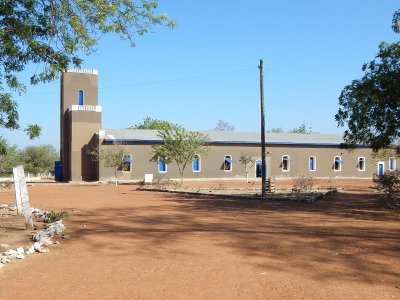
The tower collapsed in the 1980s and had to be rebuilt but otherwise the building is still strong and officially listed as a historic monument. It is now most famous for the decorations inside, added in the 1970s using traditional methods of painting on mud-relief. Only three colours are used - red, black and white. The women of the local village of Sirigu (which features in many of the tourist guide-books because of the painted houses) were given free rein with the design and the pillars are an eclectic mix of traditional and Christian motifs. This is my favourite:
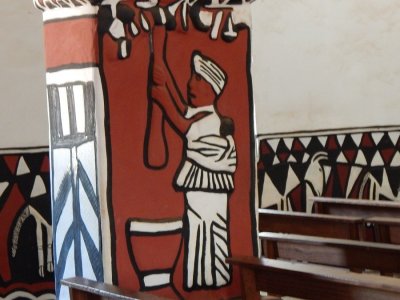
It depicts a traditional Ghanaian folk-story, similar in a way to the Fall in our Christian Bibles. Once the gods (represented by the blobs at the top of the pillar) dwelt very close to mankind and spoke directly to people here on earth. But the women, pounding fufu with their pestles and mortar, kept poking the gods with the stick and they gradually moved further and further away ...
And here are my travelling companions: Monica Cowell, our most recent oblate, and the two postulants Br Eric and Br Romeo. Br Eric is due to be clothed as a novice at Pentecost:

The White Father's mission at Navrongo began in 1906 and was the first Catholic presence in the north of Ghana. The house where Fr Peter and Fr Bernard stayed was demolished a year or two later to make room for something more permanent, indeed still essentially intact eighty years on although the only occupants are birds. A monument nearby commemorates their host of that night, Mgr Oscar Morin, M. Afr.:
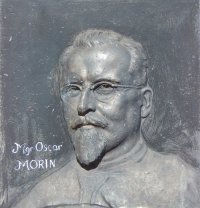
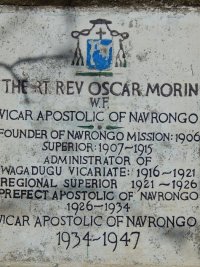

From Navrongo it was not far to the border with Burkina Faso. Until fairly recently the country was known as Upper Volta and normally featured in any short-list of the poorest countries in the world. It is a country of contrasts, however. Since the end of the last century a new suburb of hi-tech buildings has grown up on the outskirts of Ouagadougou (known as "Ouaga Deux Mille") and the city somehow has an air of cosmopolitan urbanity which is lacking in our own capital, Accra. True for the city, but the countryside is probably unchanged apart from the narrow main-road running through the landscape. Through a camera lens you could imagine yourself miles from anywhere.
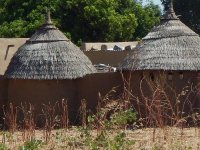

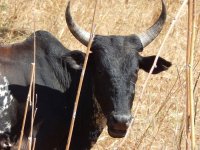
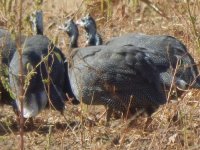
The most impressive building in the Ouagadougou is the Catholic Cathedral. It is of brick, probably built in the 1930s. The interior is very tranquil, bathed in a gentle light after the glare of the tropical sun outside.
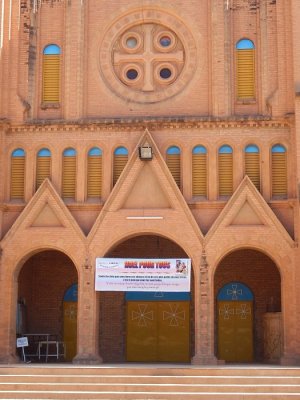
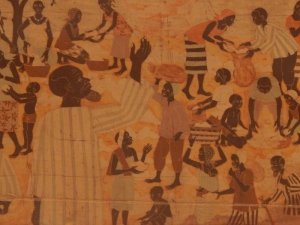
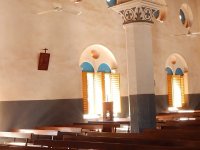
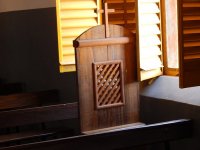
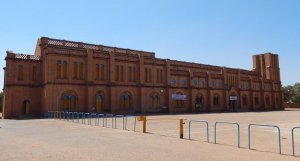
Our journey's end was the Benedictine monastery at Koubri, which belongs to our Subiaco-Cassinese Congregation. Four of our friends - freres Jean-Christophe (the Prior-Administrator of Koubri), Edmond Amos, Innocent Daniel and Jean Bosco - were being ordained to the priesthood, all had spent some time at Kristo Buase some ten years back to improve their English under the direction of Miss Monica Cowell. We were all happy that she was able to be present to share their joy. The following pictures have been loaded as a lightbox: if you click on them they will enlarge.
After the ordinations we headed straight home to be back in time for the solemnity of the Immaculate Conception, but in 1927 Fr Peter Harris and Fr Bernard Clements continued westward after returning to the Gold Coast. Their journey took them through Tumu, Lawra, Wa, Banda-Nkwanta, Sunyani, Techiman and finally back to Kumasi. At the end of it they made a report to the Bishop of Accra that the most promising areas for an Anglican Mission would be Lawra or Wa Districts. I found some documents in the Ghana National Archive which showed that the Government had assigned Lawra-Tumu district exclusively to the Anglicans for a mission. Bishop John Aglionby proposed to open two stations, presumably in the two principal towns of Lawra and Tumu, each with three European missionaries, one of whom would be a medical doctor. The projected starting date was about September 1931 (when the last six ordinands being trained by the monks would be ordained priest) but by April 1931 all the Anglican Benedictines had returned finally to England, two of them to retrain as Roman Catholic priests for Westminster Archdiocese. The Anglican northern mission ended before it had even begun and this north-western corner of Ghana, evangelised from 1928 by the Missionaries of Africa, is now a stronghold of Roman Catholicism.
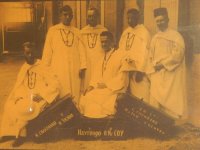
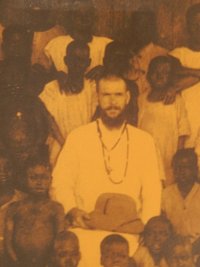
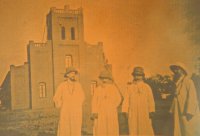
The choice of Tumu may have influenced Captain R.S. Rattray, the Government Anthropologist, to make the town the base of his last eighteen months of anthropological fieldwork (1929-31) for his book "Tribes of the Ashanti Hinterland" before he returned to England on reaching the Colonial Service retirement age of 50. Rattray is still remembered as the author of several extensively researched studies on Ashanti culture. The first volume ("Ashanti", 1923) included two chapters on a research trip to our village of Tanoboase to visit the shrine of the river-god Tano. He was the first European to be allowed access to the Sacred Grove and the shrine of Tano in the rocks about two miles from our monastery. In fact he was a man of parts. He was one of the first to pilot a small aircraft across the Sahara from England to Ghana (landing at Tamale early in 1929; he was flying a Cessna Moth), and as the following photo shows, he was not averse to a bit of big-game hunting. This elephant-kill was in Volta Region, the easternmost part of modern Ghana.
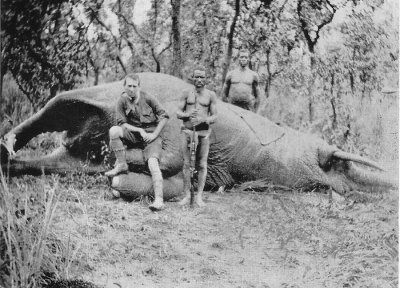
Rattray occupied a semi-derelict bungalow, reputedly haunted by a friend of his who had died there of typhoid fever. There was talk also of the ghost of another British Colonial officer, "Fergusson", who appeared occasionally with a pack of lions. Rattray never saw them. I haven't had a recent opportunity visit Tumu but it was a pleasant discovery to find that the ruins of the old District Commisioner's house at Lawra are still standing alongside the modern residence of the District Chief Executive. The watchman allowed us to wander around. It would have been a fine house in its day. The monks recorded in their diaries of the trip that it was in this house, in January 1927, that they celebrated the first ever Anglican Mass in this northernmost part of Ghana.
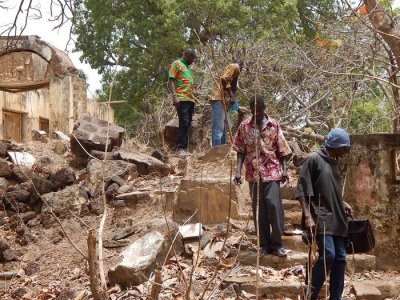
Lawra is otherwise remembered as the place where Kwame Nkrumah, the first President of post-colonial Ghana was imprisoned during the struggle for independence. Sadly, in trying to preserve the memory of the place, the local authorities have destroyed the actual building and put up something looking rather like a mausoleum.
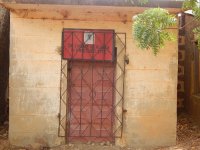
On the way back to Kumasi Fr Peter and Fr Bernard encountered some railway engineers at Banda Nkwanta surveying the route for a railway north. Ninety years on that project is back on the drawing board. Sometimes things move slowly in Ghana.
Anglican Benedictines in the Gold Coast
19 Oct 2014
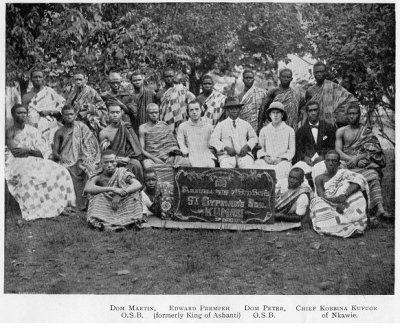
When I tell people I am working on the history of Nashdom's foundation in Ghana, I always get the same response: " I didn't know Nashdom had a foundation in Africa!" It was indeed short lived (1923 - 1931) but had a lasting influence on the development of the Anglican Church in Ghana. The photo shows two of the monks (Fr Martin Collett and Fr Peter Harris) with Prempeh I, the Asantehene, who in 1924 had been allowed back to the Gold Coast from exile in the Seychelles, just a year after the monks arrived in Kumasi. The British Colonial Government would at first only allow Prempeh the status of a private citizen, "Mr Edward Prempeh", but for his people he continued to be the King of Ashanti. Prempeh had been converted to Christianity during his long exile and had been baptised as an Anglican. That, too, complicates the story of this monastery : a colonial Church which found itself at the heart of an African "establishment". There was nothing ordinary about this place.
Strictly speaking, St Gregory's Monastery, Kumasi, was not a foundation of Nashdom but of Pershore Abbey in Worcestershire. The move to Nashdom came only in 1926. Pershore was the Anglican continuation of Caldey Abbey after the majority of the monks on that Welsh island decided to become Roman Catholics in 1913. They are therefore our monastic cousins, despite the difference of denomination.
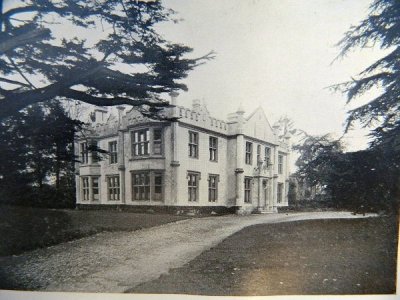
The Pershore community officially opened on 1st May 1914 and, after a rather shaky start, established its own identity under Abbot Denys Prideaux. Although only a Regular Oblate and not a monk in vows, he had been well known to many of the visitors to Caldey as Warden of the Guesthouse under Aelred Carlyle. In 1923, when the community was still only nine years old and very weak in terms of monks in Solemn Vows, Abbot Denys made the surprising decision to send some of his most promising monks to the Gold Coast. He had received an invitation from Bishop O'Rourke, Anglican Bishop of Accra the previous year.
Two monks were sent out in March 1923: Fr Peter Harris and Dom Dominic Carter, who had then just completed his theological studies at Chichester Theological College. They took charge of St Cyprian's parish, Kumasi, and converted the mission bungalow next door to the church into "St Gregory's Priory". Both buildings are still standing. I will try to post some modern photos in a later blog but here is the interior of St Cyprian's, Kumasi, in 1923:
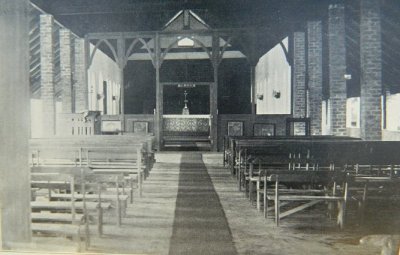
They also had pastoral charge of a mission territory roughly the size of Wales, comprising the modern Ashanti region and much of Brong Ahafo. In fact Kristo Buase Monastery has been built in their former "parish" and from the viewpoint by our rock-shelter, we can look across to Nkoranza, which was one of their main out-stations. Fr Peter mentions the shrine of Tano at Techiman in one of his letters home, and so may have visited our village of Tanoboase. This map (from the back cover of an issue of "The Golden Shore" for 1946) gives an indication of the extent of their territory and the location of their out-stations, even though it was published fifteen years after their departure. Ashanti is the northern part of the map, everything above the dotted line:
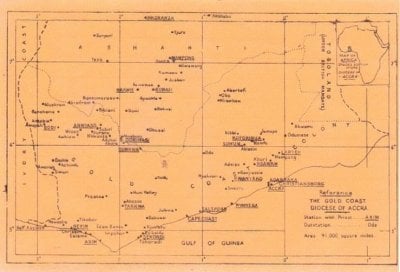
The monks were also given charge of "St Augustine's College" for the training of African priests. This is the work they are best remembered for today. The first rector, Fr Martin Collett, did not adapt well to life in Africa and soon returned to Nashdom (where he became the second abbot a few years later), but Fr Bernard Clements - a huge man physically, well over six feet tall, twenty stone or so in weight and taking size 13 shoes - made an indelible impression on his students. Here he is in the Nashdom white tropical habit with black birretta:
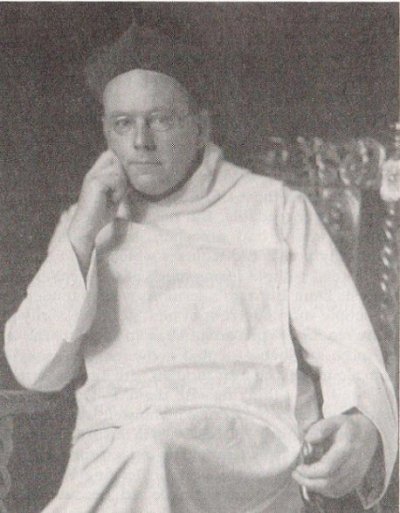
There was also an outdoor variant of the habit with a solar-topee. This is Fr Peter Harris at a scout camp at Jachie, not far south of Kumasi:
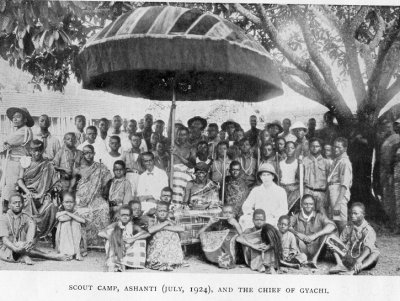
And this one, evidently at the school, is probably Dom Francis Wheeler, who was in his early twenties at this time:

Fr Francis was ordained in St Cyprian's Church, Kumasi, in February 1926. This group shot from the ordination (with Bishop John Aglionby of Accra) shows the community as it was in 1926:
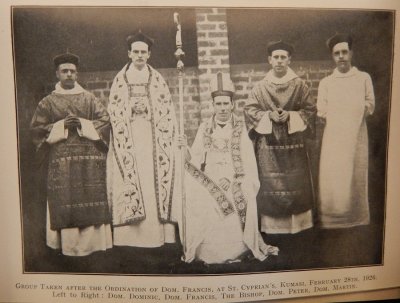
St Augustine's College has now been demolished and the site is occupied by Kumasi Anglican Secondary School, very near to Kumasi Polytechnic. I had been trying to reconstruct it in my mind's eye from descriptions in a biography of Fr Bernard Clements, so it was a special pleasure to find in one of the boxes of the Nashdom Archive a copy of the orignal blueprint of the plans. This was the chapel:
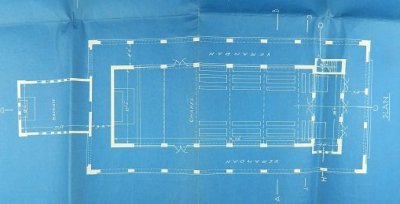
It had an organ loft (although I'm not sure an organ ever arrived), a statue of Our Lady by Martin Travers, and very elaborate vestments shipped out from England. These are the copes used for the feast of St Augustine in a photo taken outside the College Chapel. The large figure on the right is Dom Bernard Clements:
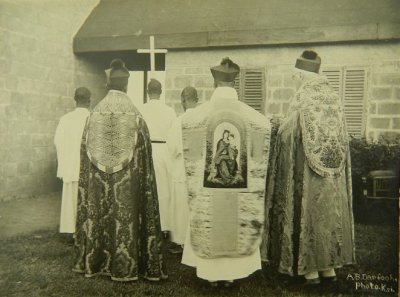
Dom Gregory Dix, the famous liturgist, also spent some time in the Gold Coast in 1927. He had been intended as a Lecturer for the Theological Training College but spent much of his time in hospital with appendicitis, and eventually had to be invalided out of the country. The monks' work was not confined to Ashanti. Dom Dominic Carter was ordained in Sekondi Cathedral within months of arrival and was quickly reassigned by the bishop of Accra from Kumasi to Christ Church, Cape Coast, and from there was transferred to Sekondi. St Andrew's Church, Sekondi, was destroyed by fire on Friday 5th February 1932, but this rather faint sepia print shows the church as Fr Dominic Carter would have known it. The church was on the ground floor, the bishop lived in a bungalow above it.
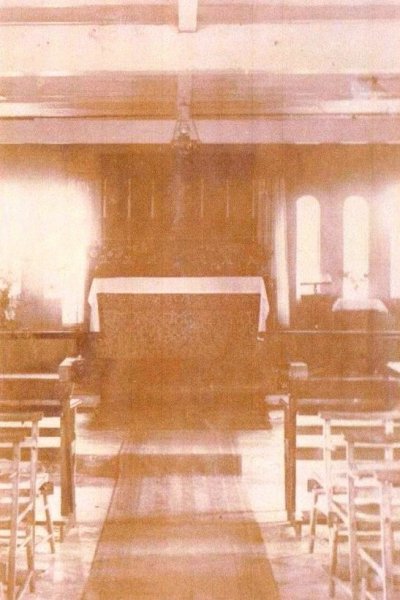
The monks of St Cyprian's Church, Kumasi, had two royal visitors from England in 1925: The Prince of Wales (the future Edward VIII), and Princess Marie Louise. This photo shows Fr Martin Collett talking to the Prince of Wales (right foregound, with his hands behind his back) in the grounds of the Residency in Kumasi. There is another monk on the left of the photo whose face is unfortunately obscured. It must be Fr Francis Wheeler since Fr Martin and Fr Francis were the only two monks present when Princess Marie Louise visited at about the same time.
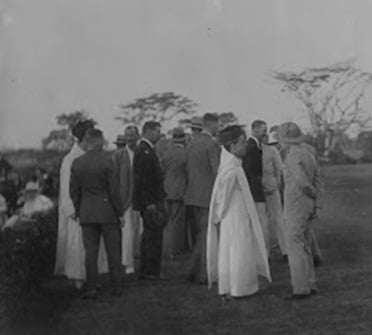
Princess Marie Louise wrote up her encounter with the monks in her "Letters from the Gold Coast", which was among the books given us by Nashdom in 1989. An additional interest lies in the end pages which have a map of Princess Marie Louise's tour, because in 1930 Fr Peter and Fr Bernard went north, retracing her route, in search of a site for a new monastery. They had settled on the area between Wa and Lawra in the Upper Territories (now Upper West Region) as a suitable location and had reported back to the Bishop of Accra requesting that he approach the Government to have this area assigned to the English Church Mission as a territory for Anglican development.
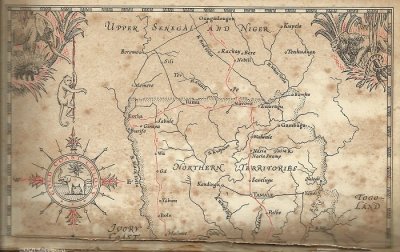
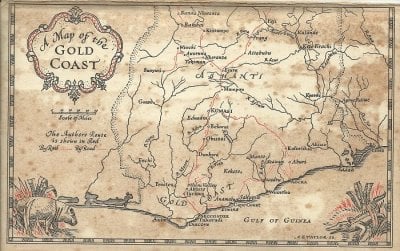
Sadly, it was not to be. 1930 was a year of crisis. Both Fr Peter and Fr Dominic decided to become Roman Catholics and left the community, returning permanently to England and leaving Fr Bernard Clements alone in the Gold Coast to run the seminary. Abbot Denys Prideaux took the inevitable decision to recall him to Nashdom since there was no longer a vestige of monastic community. Fr Bernard left the Gold Coast obediently but reluctantly, asking his African students to pray that the Lord would open a way for him to return one day. In particular, he was hoping to return as a missionary to the Northern Territories. Instead he found himself invited to become Vicar of All Saints, Margaret Street, in London. It was one of the most celebrated churches of the Anglo-Catholic movement and Dom Bernard Clements made a brilliant name for himself as a preacher and broadcaster before his premature death in 1942.
And that might have been the end of the story. But contacts between Ghana (as it became in 1957) and Nashdom continued. Br Bernard Clement Ananie, an Ashanti Catechist, joined the community around 1955 (he made first vows on 15th August 1956), and Br Francis Thompson, a Ga from Accra, joined him in 1958. He was professed in temporary vows on 14th September 1959. Theirs are the African faces which appear unexpectedly in the Nashdom photo booklet of 1961. This is Br Bernard Clement Ananie with Abbot Augustine outside Nashdom Abbey:

and this Br Francis Thompson:
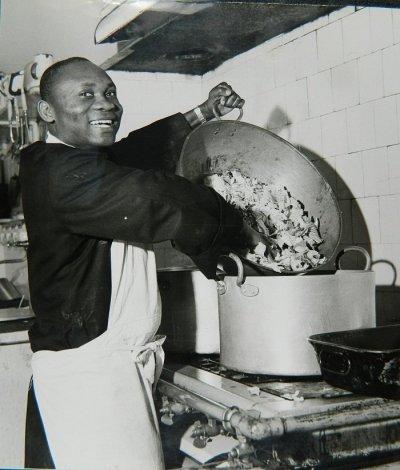
Br Bernard Clement Ananie fell seriously sick and had to be admitted to hospital. He came close to death. On medical advice he left the community and returned to Ghana in 1960. Br Francis Thompson also left around 1962 during simple vows and returned to Accra where he was ordained deacon on 29th September 1963, then priest (in Cape Coast) on 30th August 1964 - and finally bishop of Accra.
The last direct link between Nashdom and Ghana was Fr Cyprian (Henry) Martin, an English missionary who had spent eleven years in the Gold Coast (1948-59) as chaplain to St Monica's, Mampong. He arrived as a novice at Nashdom in 1959, was professed in 1961, and later represented Nashdom at the consecration of the new St Cyprian's Cathedral, Kumasi, in 1973. He preached at the Pontifical Mass of Thanksgiving for the inauguration of the Anglican Diocese of Kumasi on 10th June, 1973. Dom Cyprian Martin was made Prior of Nashdom in 1979 and died of a heart attack on 23rd January 1982.
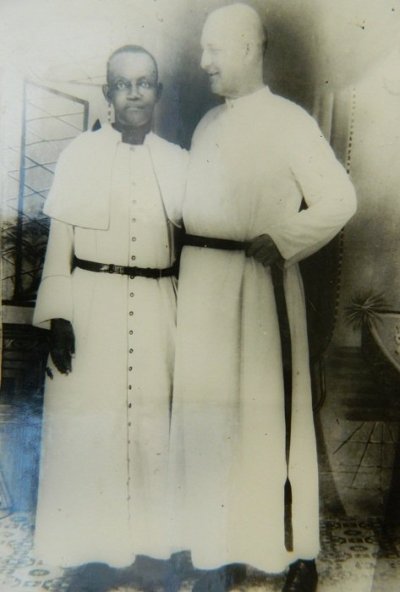
The photo was taken at Cape Coast and shows Fr Henry Martin with Ven. K.P. Sakyiama, one of Fr Bernard Clement's original students at St Augustine's College. Fr Sakyiama went on, in 1961, to become Priest-in-Charge of the old Benedictine Parish of St Cyprian's, Kumasi.
I am collecting materials to try to write up the history of the Kumasi Benedictines. If you would like to read more you will find some extracts from "Laudate" (the Pershore / Nashdom quarterly magazine) on the 'Archives' page. Archive & Monastic History
Picture Credits: Nashdom Archive (including plates from "Laudate"), except for: Map from "The Golden Shore" (St Nicholas Seminary Library, Cape Coast, Ghana); "St Andrew's Church, Sekondi, before the fire of 1932" (Private Collection: Mr T. Sakyiama, Cape Coast, Ghana); "Dom Bernard Clements in Africa", from Good & Faithful Servants: The Vicars of All Saints' Church, Margaret Street, London W1, by Peter Galloway & Christopher Rawll, Worthing 1988, p. 135; "The Prince of Wales with Fr Martin Collett", Blog of Mr Peter Dixon, The Nashdom Chronicles; "Endmaps from Letters from the Gold Coast, London 1926, by H.H. Princess Marie Louise", Kristo Buase Monastery Library; group photo at Fr Francis Wheeler's ordination from "The Golden Shore" (Magazine of the Accra Diocesan Association), 1926: copy from the SPG archive, Bodleian Library, Oxford.
The Spiritual Journey of Fr Bartholomew Banzie, OSB
9 Sep 2014
Tribute from the monastic community of Kristo Buase for the funeral in Techiman Cathedral, 10th September 2014.
Fr Bartholomew William Kobina Banzie was born in Obuasi, Ashanti Region, on the 28th April 1953. He used to joke that no-one actually came from Obuasi – everyone was simply there as a migrant worker for the gold mines. He considered the village of Nanvilli, in Kaleo parish, of which his father was later Chief, as his true home. He was a Northerner through and through, even though he spent nearly all his life in the South.
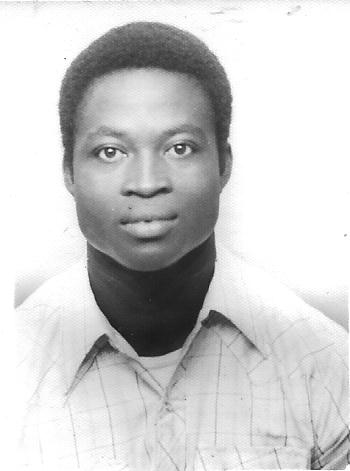
In recent years Fr Bartholomew hinted several times in his homilies at Mass at having undergone traditional rituals and initiations through his childhood and he retained many traditional beliefs which he valued as part of his cultural heritage as an African and as a Dagao. His Christian journey started later in life. He was already twenty years old when he was baptized at St Paul’s Church, Sekondi, on 30th June 1973, and was confirmed and given first communion the following day. He spent most of the 1970s in Sekondi-Takoradi, studying welding at Takoradi Polytechnic and later employed as an Artisan Welder at the Cocoa Products Factory (GCMB), in Takoradi.
Fr Bartho had several catch phrases which he liked to use. One was “It isn’t easy”, and certainly his entry into religious life was a struggle, which took him more than ten years to accomplish. An early attempt to join the FIC brothers in Wa Diocese came to nothing. From 1980-82 he was with Fr Anthony Mensah-Brown as a novice at Divine Providence Monastery in Kumasi diocese, but left before vows. After that he tried his vocation with the Spiritans and joined their novitiate in the Gambia, but that, too, came to nothing and he was sent away. He had done nothing wrong, but the novice master felt he had no particular calling as a missionary.
Bartho returned to Ghana, and later described himself as greatly distressed and unhappy at this time. He attached himself to a monastic experimental community at Kuntunase, near Lake Bosomtwi in Ashanti. The brothers there had mostly broken away from Divine Providence Monastery and when that community was given canonical recognition by the Bishop of Kumasi, the bishop advised them that their own small community had no future in the Church. They were advised to disperse and were given three options: to return to Divine Providence Monastery, join the established monastery at Bamenda in Cameroon, or seek to join the new monastic foundation planned for Sunyani Diocese at Tanoboase.
And so it was that in 1986 Bartho made contact with Br Bede Kilgallon and the English monks who were preparing to come to Ghana and was accepted as an aspirant. For the next three years he, and Emmanuel Boateng who had also come to Kristo Buase from the Kuntunase experiment, helped in the preparation of the site and building of the monastery at Kristo Buase. Bartho was at that time living in the sacristy of Tuobodom Catholic Church.
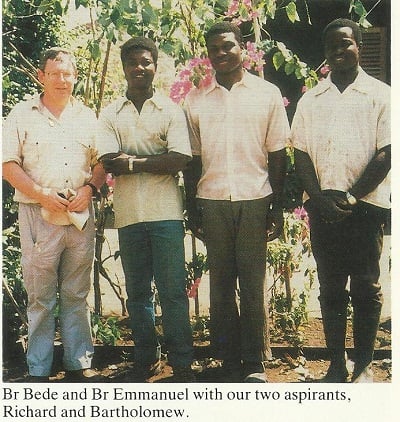
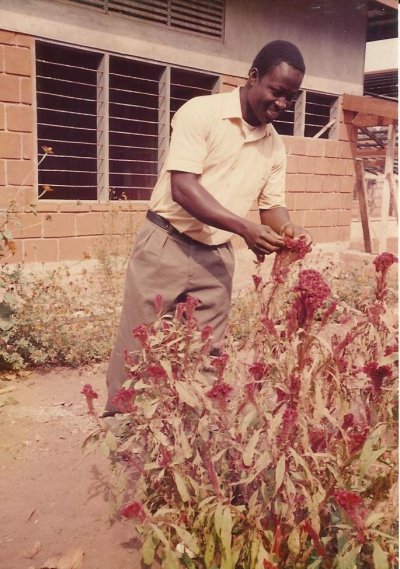
He was accepted as a postulant soon after the canonical opening of Kristo Buase Monastery on 5th August 1989, and was admitted to the novitiate on 8th December 1990, making first vows two years later on 8th December 1992, and then became the first Ghanaian member of the community to make Solemn Vows. That event took place at the monastery on 16th May 1996, Ascension Day. Shortly before his final profession, he travelled to Britain for three months to represent the Kristo Buase community at the centenary celebrations at Prinknash Abbey. That was the first time I myself met him. He was warm and enthusiastic about Kristo Buase and encouraged me to come and visit the community. Another of the British monks, who knew him in the early days of Kristo Buase has commented on how much he owed Fr Bartho, not least as a guide to Ghanaian culture.
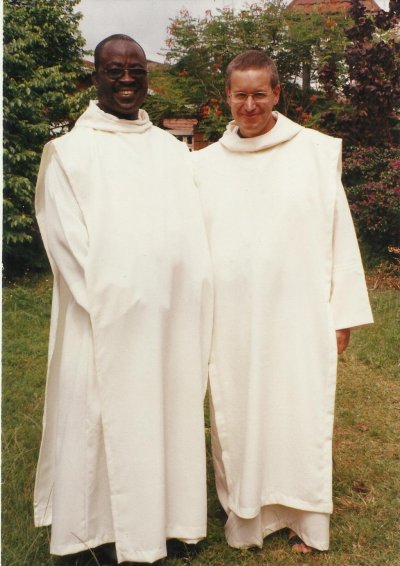
Soon after Solemn Vows, Bartho was sent for studies for the priesthood. He spent three years with the Spiritans at Ejisu, and then four years with the SVD community in Tamale while studying at St Victor’s Seminary. There was a large age-gap between him and most of the other students since he was already in his forties, but he made many friendships during this period and many Spiritan and SVD priests regularly sent greetings to “Uncle” and called in to visit him at the monastery. Most of his class-mates are now missionaries overseas.
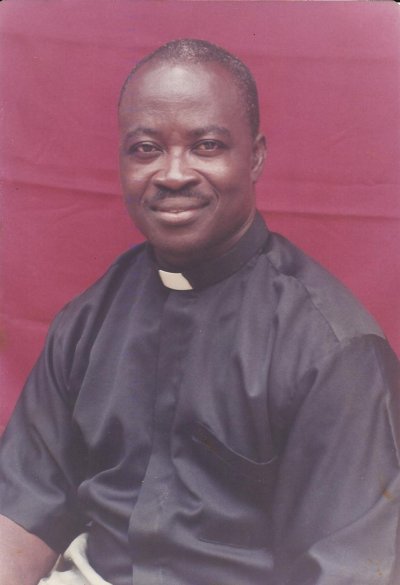
These seven years away from his monastery brought several problems Fr Bartho had been encountering earlier to a head. After ordination to the priesthood he began to wonder about a more pastoral vocation and was looking for opportunities to move abroad, particularly to the United States of America. When various plans fell through, he arranged to spend one year in Trinidad giving pastoral assistance at Mount St Benedict Abbey. The work permit arrived in July of last year, but the Lord had other plans for him, and while we were planning his journey his health suddenly deteriorated and the heart condition he had been struggling with for the past ten years finally caught up with him. He died peacefully on the night of Monday 18th August, in the presence of one of his monastic brothers. He was 61 years old, 10 years a priest, and 21 years professed as a monk.
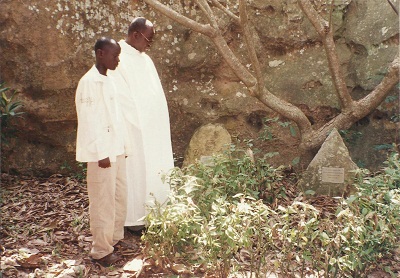
Fr Bartho had known for many years that he was likely to die young. He often told us that he liked to pray the rosary in the monastery’s cemetery, meditating on where he would be laid to rest. And today we shall bring him to the end of his earthly journey, to bury him beside Fr Martin Symons who had been his Superior and Novice Master when he first entered the monastery twenty-five years ago. May the Lord now grant him that peace he sought so long, and show him his mercy and love. Amen.
Fr Ambrose Flavell, OSB
School Outing to Kumasi
15 Jul 2014
The Father Martin Memorial School was founded in 1994 as a memorial to our first Superior, Fr Martin Symons of Ramsgate Abbey. It continues to receive a steady flow of donations from benefactors in the UK and in April we gave £700 from the school fund to subsidise an outing to Kumasi, the second city of Ghana, for almost the whole school. It was the first such outing since 2007. Here the students themselves give an account of the day:
It was Friday afternoon when a bell was tolled for closing. We were all to assemble. After praying and everything else, the Headmaster came out from his office for an announcement. Surprisingly to his announcement he said the school would be embarking on an excursion to Kumasi at four important places like River Barekesse, Kumasi Airport, Kumasi Zoo and Cultural Centre. A very amaze and astonish for the school was that the Monastery Fathers has promised to hire two Yutong busses free for both primary and J.H.S. schools. After his announcement the whole school was like a jubilee house.

On Thursday the teachers in our school closed us early in the afternoon. And our headmaster told us now our dream to go on excursion has come true. We all cheered with our friends and everybody was exited that we are about to go to such important excursion, especially those who had not gone to Ashanti Region before. Then the assistant headmaster added that, you know we have not been closing by this time. The reason why we have closed early is that we want each and everyone here to go back home and wash his or her uniform and iron it. Another teacher added that, by God’s grace tomorrow we are going to take off at 6:00 a.m., early in the morning. Then we all departed to our various homes preparations towards the excursion.
Finally the day came. On Friday 4th April 2014. As early as 5.30 a.m. we all dressed nicely and went to our town park waiting for our busses to arrive over there. We sang many songs and danced with joy. At 6.00 a.m. the busses arrived at where we were. The busses were three: one for the primary pupils, another for the J.H.S. and the third was for our teachers and our luggage. One of our teachers pray to God and asked for God’s travelling mercy. At exactly 6.30 a.m. we began the journey to Kumasi. On the way we sang many and danced until we arrived at Barekesse Dam.
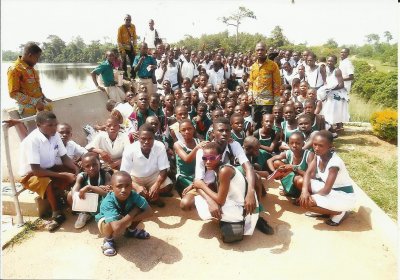
Sir, what was amazing was that when we reached a certain town our bus also overtooked that of the primary pupils and we tooked a certain road. All of us were shouting due to the fact that the road was second class road since we don’t know there we didn’t say anything again due to that fact. I continued the reading of sign boards, what I saw was that they have written ‘Welcome to Barekesse’. The Barekesse dam is the one of the happiest places I visited because that was the first day I saw a canoe and dam.
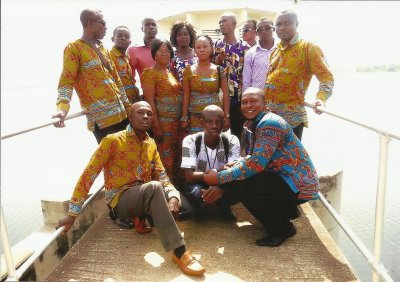
We were singing and drumming loudly but the moment we got to Barekesse Dam, we gave up singing and drumming. There we were told by one of the workers there that the Dam was built at the era of our former president Dr Kwame Nkrumah in the year 1960 by Russians. And also the main purpose for building it was to generate electricity and also served as a source of potable drinking water for the country especially those in Ashanti Region. And the dam get it source from river Offin.
Sir, we boarded the bus again and we therefore continued our journey from Barekesse. We were given food. From Barekesse we went to main city / capital city of Otumfuo Osei Tutu II, that is Kumasi. The first place we visited was the airport. Our bus was first to reach there. I saw an aeroplane landing there off in the air that was when it was too big to fly when it is on the air. You may say it is a bird but it is bigger than even our bus so I was thinking about how it manage to fly in the air over there. When we were standing there it was noisy. Happy because I spoked to an instructor over there and saw an aircraft also.
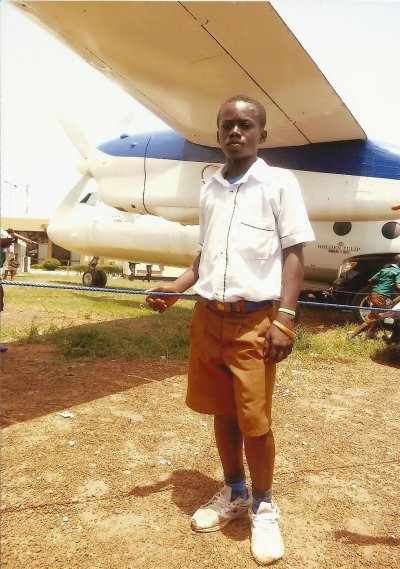
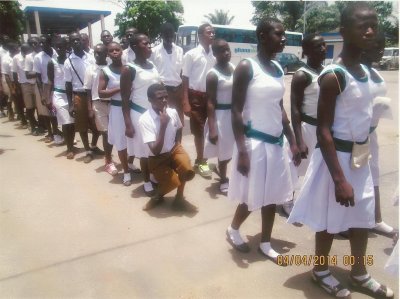
From the airport we went to Kumasi Zoo. At the zoo gate the tourist guides counted us and charged us an amount, as soon as we paid the levy they group us into two and two men led us. At this stage he explained some habits of animals to us. We asked him a lot of relevant question, he also answered a lot of questions patiently. I saw so many animal like species of birds, an elephant, antelope, tortoise, lion, tiger and that was the day I saw a tiger with my naked eyes. I also saw a monkey which danced “azonto” even than a human being named “Gimi”.

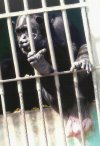



We took our lunch at the zoo, after we boarded the busses again and went to our last place which was Kumasi Cultural Centre.
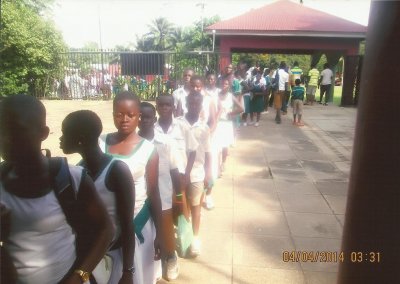
In the cultural centre they divided us into two groups. First group went to a certain room and the second group also went. I was with second group. A certain man gives us so many history about the Ashanti Kingdom. We went in to saw many tools and equipments used by the Ashantis in the olden days. He also showed us the picture of Yaa Ashantewaa and the picture of Prempeh the III (third). We also saw very excited first car bought by Prempeh the III.
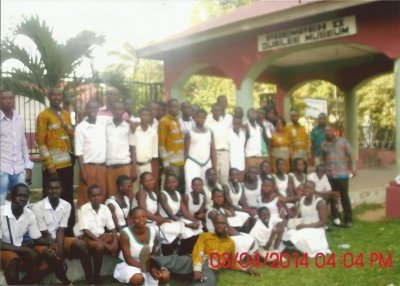
At exactly 6.23 o’clock we took off back to Techiman. I could say Wa ‘O’ because the excursion was interesting and very educative, so therefore our teachers advised us to learn hard and further our education to a higher levels so as to enjoy a brighter future too.
In fact I gained a lot from the excursion because through this excursion I had seen so many animals, cultures and histories which since I came onto this planet I haven’t seen before and also heard before.
Thank you,
Furvour Lord Aryee, J.H.S. Three.
Donkor David, J.H.S. Three.
Bediako Evans, Form Three.
Ntim Widom, Form Three.
Ali Latif, Student
Fr Martin Memorial School, Tanoboase, 14th April 2014.
Fish and Chips Babies, Ghana
26 Jun 2014
Visitors to the monastery often ask, "What can I bring for the monastery?" It used to be simple: "Cheese, whisky, marmite ..." now we often add "and a bag of baby jumpers!" These knitted items have been shipped out from Scotland to help premature babies in our local hospital in Techiman.
I am grateful to Kathleen Hoy of Aberdeen for sending this account of the project, and the Medical Mission Sisters in Techiman for providing photos of the jumpers in use. Fr Ambrose.
2,159 knitted baby items have been sent to Ghana and Romania since 2012: 1,584 jumpers, and 78 booties.
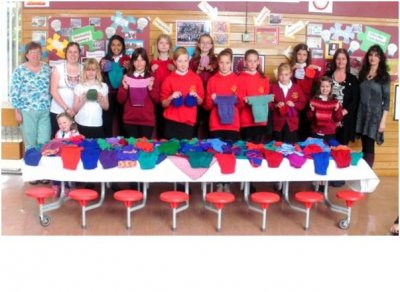
St Thomas Primary School, Arbroath donated jumpers, hats, booties, scarves, blankets and mitts for the cause on 18th June 2013. Mrs Fenton P7 teacher (far right back) and Mrs Hill (2nd far right) knitting tutor, with the group of young knitters.
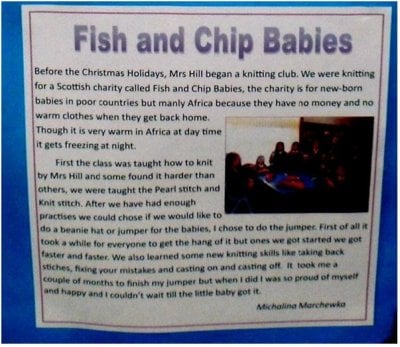
Thanks to the dedication of Mrs Hill and her band of knitters, we were able to make a sizable donation of baby clothes which will be taken to some of the world's poorest babies. The pupils share their experience:
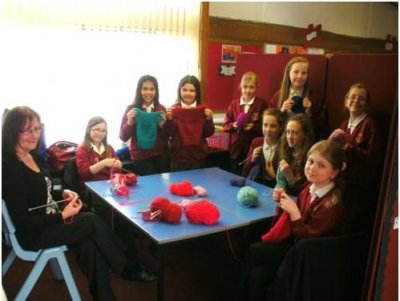
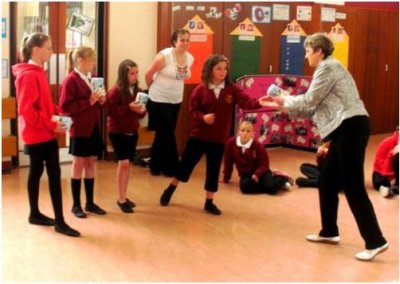
We learned about the significance of birth weight and survival – using 1 Kg bags of sugar (a baby born in the UK weighs approx 3-4Kg in Ghana between 1-2 Kg).
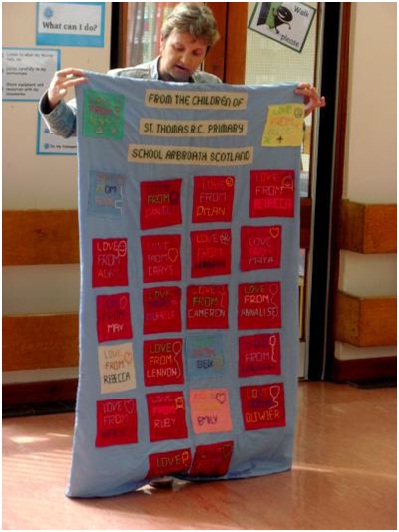
Miss Hood (now retired) Head teacher presented embroidered blanket for the Maternity hospital in Romania.
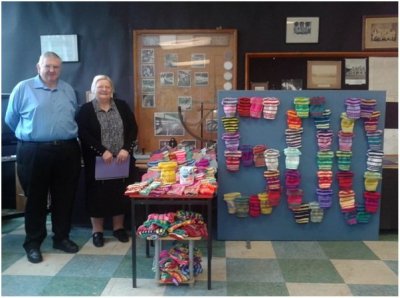
Ann Philip receives a voucher for the Papetrie on completion of her 500th jumper! 26th June 2013.

The bag of sugar represents the typical weight of a baby in the premature ward in Holy Family Hospital, Ghana (1Kg) it sits next to jumper number 500!
Anne has completed jumper 900 – she will retire after 1000… Thanks to her and all the knitters who have contributed – many lives have been saved and many more still rely on this basic help…
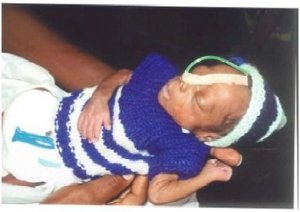
The nurse’s hand in this photo helps us see how tiny this baby is.
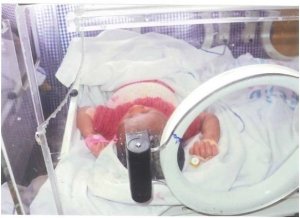
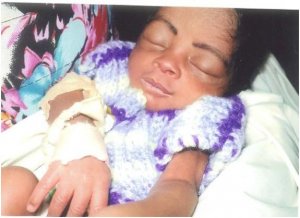
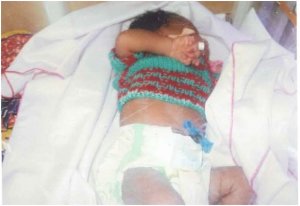
Babies of the Holy Family Hospital, Techiman, Ghana.
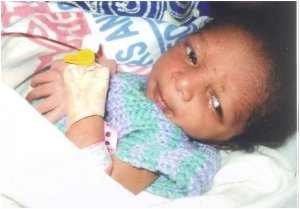
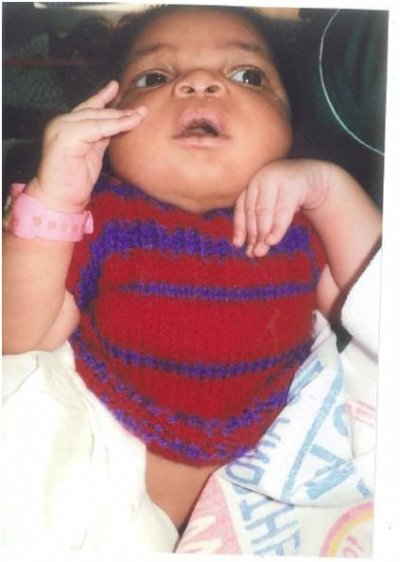
Note the food sacks used as blankets.

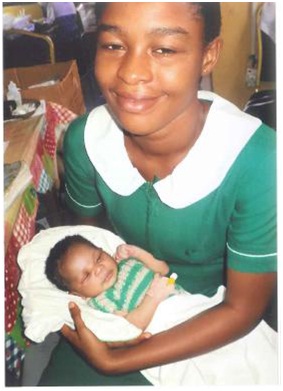
Nurses (in green) caring for the babies.

Maternity Hospital, Romania “This is fabulous. What a wonderful way to welcome a new life. Somebody who I don’t know who lives far away in a country I don’t know loves me enough to give me a welcome to the world gift. Thank you bless you. I love you x”
With thanks… •to all the knitters for their dedication and love. •to the monks and oblates of Pluscarden and Prinknash monasteries in the UK for taking items to Ghana and to the monks of Kristo Buase monastery, Ghana for delivering them to the Holy Family hospital. •to Standing Gables B&B for use of storage space to enable jumpers to be collected for distribution in Romania by North East Scotland Support for Romania. •to everyone who has helped support in so many other ways!
##SHOW-MORE-LINK##Visit of the Prinknash Oblates
15 Jun 2014
As part of our Jubilee year celebrations (which will climax on 5th/6th August 2014) a group of six oblates and friends of Prinknash Abbey came to spend ten days with us in March. Prinknash is our “mother-house” and we were happy to welcome back Fr Martin McLaughlin with the oblates. He is a monk with many hats: on this trip he came primarily as one of the Oblate Directors but he is also Bursar of Prinknash and handles Kristo Buase’s finances in England.
The photos in this blog were taken by Sally Mercer. The group arrived at Accra on St Patrick’s day. The trip got off to a good start with a meeting with our own Benedictine Oblates at Accra airport. The photos begin the next day with the journey up. This one shows a fruit stall by the road-side. No packaging or weighing scales – you buy most things in the market by the heap or measuring tin. The woman with the head-pan is selling kitchen knives.
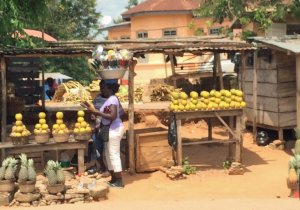
Although the journey from Accra to the monastery is only 400 km, the journey normally takes about 12 hours. We took two cars down to meet the group since African public transport can be challenging! The busses to Kumasi are good, but after that you are at the mercy of “trotros” (minibus taxis for 16 passengers, their luggage and sometimes a couple of goats), taxis of varying standards of road-worthiness or even riding pillion on the back of a motorcycle). Driving also gave us a chance to stop several times to see things. This picture is of hand weaving at Bonwire in Ashanti Region. The oblates had wanted to buy a gift for the chief and this was a good place to get one: the strips are sewn together into large cloths which are the traditional dress for men in central Ghana, wrapped round the body and thrown over the shoulder like a Roman toga. The weavers used to make use of spun silk, but since – even in Ghana – six metres of spun silk cloth doesn’t come cheap, most of the cloths are now woven from synthetic fibres. This one rather bright orange.
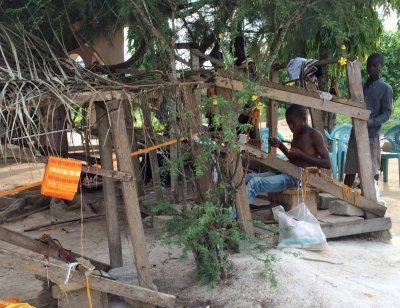
You can’t see it in the photo but the threads continue about 5 metres to the left and are pegged to the ground. The weaver is sitting under a shelter and operating a foot-pedal loom. Every cloth represents weeks of work.
It was dark by the time we got to the monastery so exploration had to follow on later. Here’s the group soon after arrival:
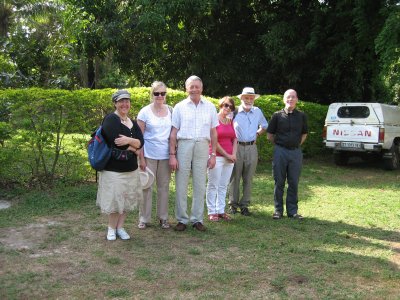
From left to right: Sarah Richards, Teresa & Stephen Day, Mary & Robert Jones and Fr Martin McLaughlin. Sally is missing since she took the photo. The Nissan in the background is our veteran Pick-up, 18 years old but still on the road.
The local speciality is fufu. Many of the villagers will eat it two or three times a day. It is a mixture of yam and plantain or cassava, pounded with huge wooden pestles into a ball. The texture is something like Italian gnocchi, but the sheer size and bulk of this ball (served under soup) catches most European stomachs by surprise.

Here is our cook, Stephen, assisted by aspirant Br Max-Romeo. Pounding can go on for about 45 minutes and requires a steady rhythm and excellent hand / eye co-ordination since the cook has to turn the ball by hand after each strike. Perhaps there will not be much call for this technique in the Cotswolds but Sally soon picked it up.
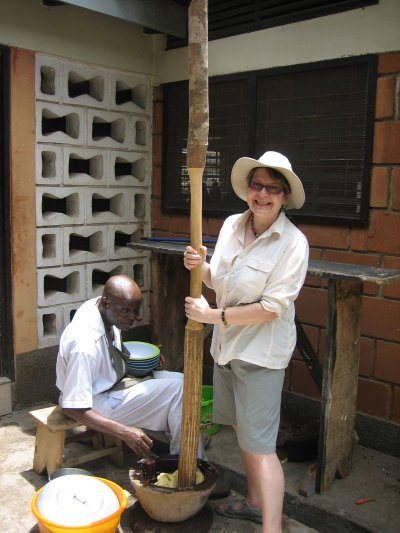
Stephen looks slightly apprehensive.
The main aim of the trip was to visit the monastery but we had a few trips out. The first was a formal visit to our local chief, Nana Amisare Dwomo II, Paramount Chief of Tanoboase, and his council of elders. A formal visit involves relaying messages through linguists and the conversation remained in Asanti-Twi throughout. This photo was taken at the end of the meeting in the palace.

Nana has been a good friend and supporter of our community since the foundation of Kristo Buase in 1989. Our monastery is built on “stool land” owned by the chief on behalf of the village. We hold the estate on a 45 year lease and pay rent annually to the Government. There are no freehold properties in Ghana outside Accra and its immediate environs.
Tanoboase is important for its traditional religious sites. It has a major shrine to the river god Tano since the source of this sacred river (which becomes the border between Ghana and Cote d’Ivoire for much of its length) lies a few kilometres from the village. The rocks of the Sacred Grove are also home to much of the Ashanti pantheon and in consequence a large area of the village has mever been farmed and has retained its traditional vegetation. Until the 1930s all this area was dense tropical forest but in the course of the past 80 years most of the old trees of central Ghana have been chopped down for commercial timber works and building projects. The Sacred Grove and the monastery estate have some of the last old trees in the district.
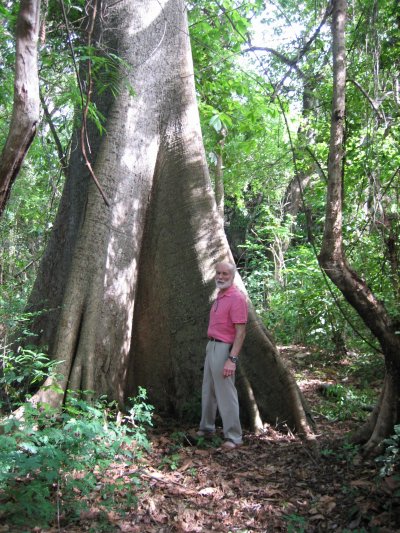
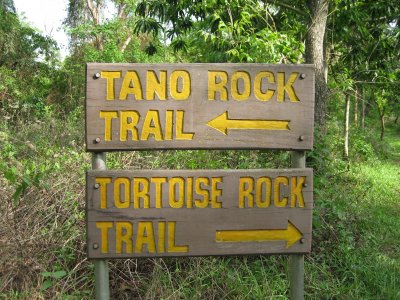
The oblates also visited the Fr Martin Memorial School in the village. It was built by UK benefactors as a memorial to our first Superior, Fr Martin Symons of Ramsgate, who died of multiple tropical diseases only five years after arrival in Ghana. Some of the group have been helping the school financially for many years so it was good to be able to show them some of the work achieved. The facilities are perhaps not as advanced as in their British counterparts:
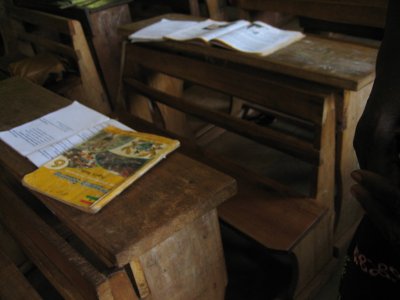
but African children always seem to be happy. We are currently working on a project to supply the school with a computer laboratory. Contributions towards this will be gratefully received.
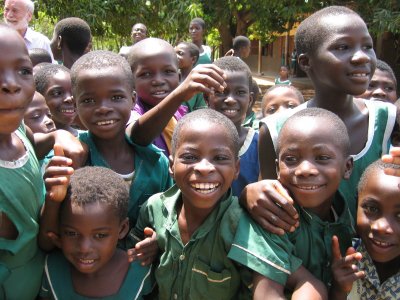
There are several photos of an outing to Fuller Falls at Kintampo, where the group relaxed before setting off south again for the airport.


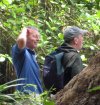


Fuller Falls were developed as a Catholic prayer park by Fr Jo Panabang, SVD, although now the district has taken the site over to develop for tourism. There are still traces, though, of the former administrators!
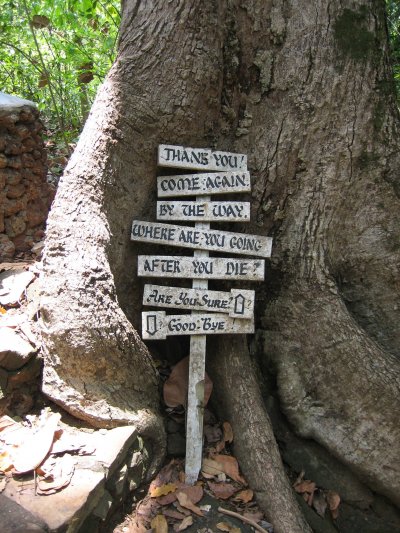
And lastly,a visit to Bishop Dominic Yeboah Nyarko, Catholic Bishop of Techiman.
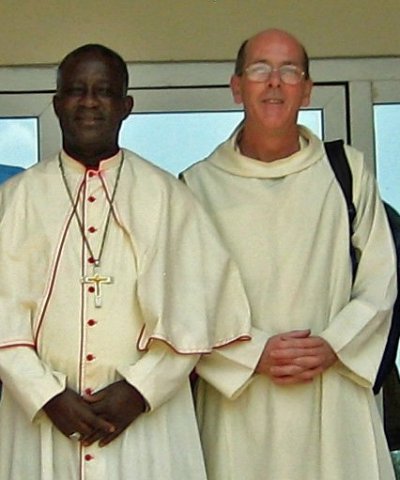
Thanks for sharing the photos, Sally!
An American friend of ours, Herbert Schultz, provided funds for us to obtain for our monastic library seven works of St John Chrysostom, and two works of St Cyril of Alexandria.
In our area, this is the season of the Yam festivals. Our guest from Prinknash Abbey, Mary Jones, attended the Tuobodom Yam festival on 24th October. These two low resolution photos she took on her phone. 

There have been a few changes in officials at the monastery:
- Brother Basilio is now Novice Master,
- Brother Antony is Oblate Master.
Please pray for these brothers who showed a great spirit of obedience in accepting these tasks.
A number of priests have been here on retreat in the past two weeks. First there were two Divine Word Missionaries, working in Accra, then Father Daniel of the Goaso diocese, and finally Father Gabriel of the Archdiocese of Accra.
At present, we have a monastic guest from the Abbey of Koubri in Burkina Faso - Brother Anthelm. He is a very cheerful presence in the community, ever willing to help. He has no English and our oblate, Monica Cowell, is giving him classes in English twice daily.
2nd November, All Souls, is a day in where traditionally the whole monastic community gathers in the cemetery for prayers for deceased community members. At Kristo Buase, we gather in the cemetery for Midday Prayers, sometimes called Sext. We also bless the graves. Our cemetery is in a quiet grove and at its entrance there is a beautiful cross.

We continue to pray for you all, and ask that you do the same for us, especially in the lead up to the Presidential Election here in Ghana in December.
THE ELEVATION OF KRISTO BUASE MONASTERY TO THE STATUS OF A PRIORY SUI JURIS AND THE ELECTION OF A PRIOR (September 2016)
THE GOOD NEWS
On the eve of the 27th anniversary of the Kristo Buase monastery the news came that the Abbot President was about to sign the document which was going to confirm and declare the long awaited autonomy of the community, from the three founding houses in England and Scotland, becoming a Priory sui juris on 6th August, 2016. On the 15th August, the community went through the process of electing their first prior (this was conducted under the supervision of the Abbot Francis of Prinknash abbey). The chapter fathers had elected the first prior of the priory and he was in the person of Dom Bede Kierney of Pluscaden Abbey. There has to be a ceremony to install him. This was the responsibility of the Abbot Francis but due to travelling arrangements, he delegated his powers to the the Bishop of the diocese of Techiman, the resident diocese of the monastery. This ceremony was to be followed by a thanksgiving mass, which the whole community in accord with the prior elect had decided to celebrate in a grand style and this required the organization of the event in less than two weeks. All was set for the ceremony of the installation on 9th September; the Bishop Dominic of Techiman had been very prompt as usual hitherto he had promised 4:00pm therefore arriving in his full regalia at ten to four. The ritual began by the reading of the declaration to the hearing of the conventual house and was followed shortly with the oath of the prior elect. Afterwards the Bishop led Dom Bede to the chapel stool at the head of the other chapel stools purposely for the new prior of the new priory and installed him on the stool. The new prior then gave his speech; calling to mind that he was actually elected to serve and not to be served. The ceremony was ended with photographs in the cloister, while the Bishop thanked Dom Ambrose Flavell who had been very instrumental on the quest of the attainment of autonomy for the house.
THANKSGIVING MASS, 10th SEPTEMBER
This event was witnessed by people of all walks of life, from the dioceses of Techiman, Sunyani, Donkorkrom, Kumasi, Ouagadougou and beyond. The event was graced by the presence of the Bishop Dominic Yeboah Nyarko of the Techiman diocese who was the main celebrant and the Bishops, Matthew Kwasi Gyamfi and Gabriel Kumordzie, from the diocese and Apostolic Vicariate of Sunyani and Donkorkrom respectively and the V. Rev. Fr. Dominic Apee, president of the Ghana major superiors Association were all in attendance to con-celebrate. Also in attendance were the priests, monks and religious from Techiman, Sunyani , Kubiri and beyond, medical personnel, Government officials, the Armed and Police forces, Chiefs and Queen mothers, etc. After the start of the mass with the long procession, the V. Rev. Fr. John Kofi Takyi (vicar-general of the Techiman diocese) gave the welcome address, beginning with a monastic quote “the challenge the society poses to the monastic life is not due to it’s alienation from social fixtures but it’s concern for the salvation of the society”, he continued to state that “the spiritual and material growth of a society is always due to the existence of the church represented by a monastery or a priory”. He appreciated therefore the effort of all who had helped the monastery to this far, urging more people to seek solitude within the confines of the of the monastery, for the renewal of the their spiritual lives.
HOMILY
Bishop Matthew Kwasi Gymfi during his homily appreciated the weather (over cast), thanking God for how far he had brought the community, describing how the environment was at the time the monastery was inaugurated and noted that “the monastery was of an impregnable spiritual repute”. He actually went into a detailed explanation of an autonomous monastery and what the new status was to expect in the near future, exhibiting the depths of knowledge he had as regards to the monastic setting. The Bishop congratulated the monastery and commended all those both dead and alive whose effort and instrumentality had contributed to the immensely to this new achievement and in silence remaindered us of Dom Martin Simons, Dom Leo, Dom Bartholomew Banzie and Bishop Kwadwo Owusu, the formers who were superiors and members of the community and the latter the late Bishop of Sunyani. He then went on to acknowledge the Nana Amisare Dwomor 2 chief of Tanoboase for his generosity and that of his predecessor, for the vast land of which the monastery is proud of. He could not finish without the acknowledgment of the gigantic support of the three founding houses; Prinknash, Pluscarden and Ramsgate now Chilworth all in U.K., for their hard work and toil to nurture for this young child of theirs to its independence. The main focus of his homily was on: independent, inter-dependent and dependent. He explained each of these and the interconnectivity they all had with each other, therefore relating it to the new autonomous priory of Kristo Buase. He stated that the independence of the community was not to be taking as the independence of the individuals in the community but the brethren were now to live most especially in inter-dependency thus each one depending on the other in the community and not each going on their diverse ways, the brethren were he said were to remain in unity in order to be strong and be bound to the love of God, as Christ himself tells us “remain in My love”. “Each member of the community”, he said, “was not to listen to the rhythm of his own drum alone but to the rhythm of the others, for he who listens to the rhythm of his own does not avail himself to new ideas, the diversities and the acknowledgment of others, which will go a long way to avoid mediocrity, vain glory and the wallowing in our ignorance due to self centeredness”. His Lordship in his conclusion made reference to the edifices of the monastic communities he had visited so far, especially those of the three founding houses of Kristo Buase and how these buildings themselves emitted and demonstrated dialogue in a special way. He made mention of the monks’ unlike the other religious congregations, resistance of the trends of the times as unhealthy and their preference for the opposing side. He ended with congratulatory messages to the first Prior of the new Priory, V. Rev. Dom Bede Kierney OSB. and the whole community and with one voice with Apostle Paul’s letter to the Ephesians1:1-3: Blessed be the God and father of our Lord Jesus Christ who has bestowed in us every spiritual blessing in Christ.
THE PEAK
The Bishops during offertory informed Prior Bede that he needed to be installed in the presence of all gathered and most especially in the presence of the Chiefs and the elders so that they could come forward to greet him, since this was something very peculiar in the Ghanaian setting that a chief does not stand to greet someone unless the person is elevated before him. Before the second collection the three Bishops installed Prior Bede of a Chiefs stool, sitting him down three time in the name of the Holy Trinity, then all came to greet him including the chiefs with his Queen mother and elders while the wonderful Dagaaba choir sang.
CONCLUSION
Rev. Dom Ambrose Flavell gave the vote of thanks, after the mass came to a close and yes he gave an extraordinary exhortation and a wonderful advice to the Prior, since he had experienced Kristo Buase as the Superior for many years. The party afterward, as now we call the reception of every great ceremony, was on point since there were provisions made for the refreshment and nourishment of all who attended the event. All left in great satisfaction, for they had been blessed by this wonderful celebration and the grace of God was now abiding in them. In the evening after the community said good bye to the oblates who came from Accra, as they were the last to leave, sat at recreation to savour the lasting sweetness of the wonderful event God had made possible through the wonderful organization skills of Dom. Gabriel Peh with the support and the cooperation of the community. The Lord has indeed been good to the community of Kristo Buase and as the psalm of the day stated: “I will bless your name forever, O Lord”, we are indeed thankful.

